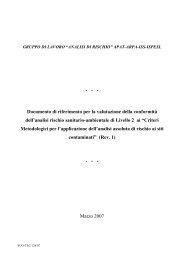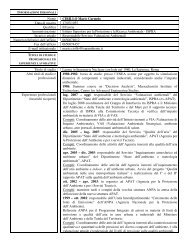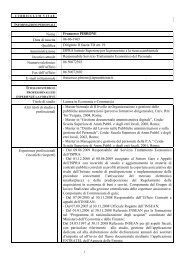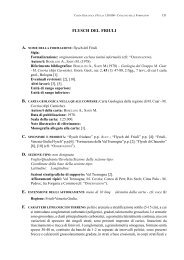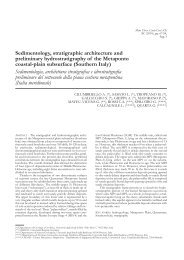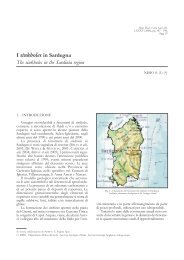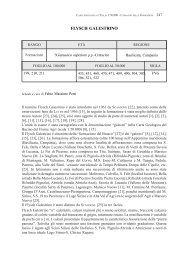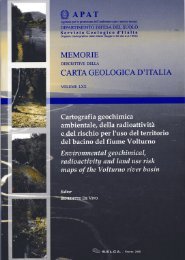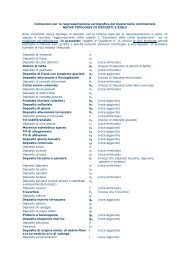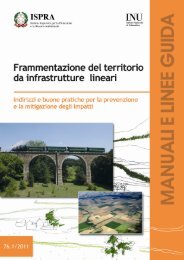Guidebook - Ispra
Guidebook - Ispra
Guidebook - Ispra
You also want an ePaper? Increase the reach of your titles
YUMPU automatically turns print PDFs into web optimized ePapers that Google loves.
Volume n° 1 - from PR01 to B15<br />
B12<br />
B12 -<br />
Leader: M. Sandulescu<br />
roxene- and hornblende-andesites of Upper Pliocene<br />
? – Lower Pleistocene age, which belong to the calcalkaline<br />
volcanic arc of the East Carpathians. After<br />
crossing the Ciucul de Jos (Lower Ciuc) Quaternary<br />
Depression, the Olt River (and the fieldtrip) crosses<br />
the south-east end of the volcanic chain. At Tușnad<br />
spa, east of the valley, the Sfânta Ana volcanic structure<br />
is well preserved. It is a very young volcano of<br />
Pleistocene or even Holocene age. Downstream, in<br />
the Micfalău area, on the right-hand slope of the Olt<br />
Valley, two subvolcanic bodies of basaltoid andesites<br />
(Lower Pleistocene) are exposed in two large quarries.<br />
On the left-hand slope and tributaries, Lower<br />
Cretaceous flysch formations of the Ceahlău Nappe<br />
are developed. At Malnaș the tectonic contact between<br />
the Ciuc Digitation and the Bodoc Digitation<br />
(both sub-units of the Ceahlău Nappe) is crossed.<br />
From Ghidfalău the Olt River runs within the Sfântu<br />
Gheorghe Quaternary Depression, filled - as the<br />
whole complex developed Quaternary depressions of<br />
the inner part of the Carpathian Bend Area - with Upper<br />
Pliocene-Pleistocene formations.<br />
Between Hărman and Brașov, south of the Depression,<br />
it is possible to reconstruct (if the weather is<br />
favourable), along the skyline, a cross-section of the<br />
Ceahlău Nappe and the front of the Getic Nappe.<br />
Stop 3.1:<br />
Săcele - Jurassic formations in the front of the<br />
Getic Nappe.<br />
In the town of Săcele, the main part of Bonloc Hill<br />
is built up of Jurassic formations similar to those of<br />
the whole Postăvaru Mts.-Codlea-Piatra Craiului<br />
Mts. area, which belong to the Getic Nappe. After<br />
a few siltic black shales of the Grestner Lithofacies<br />
of the Lower Jurassic, Middle Jurassic quartzitic<br />
sandstones follow, hosting a sill of trachytes, also<br />
of Middle Jurassic age. The Upper Jurassic is represented<br />
by massive neritic limestones. The absence of<br />
the Callovian-Oxfordian radiolarites which are usually<br />
developed in the other parts of the Getic Domain,<br />
accentuates the existence of a stratigraphic gap in the<br />
frontal part of the Getic Nappe.<br />
The Săcele Jurassic Getic formations are overthrust<br />
above the Piscu cu Brazi Formation (see Stop 2.4)<br />
of the Ceahlău Nappe.<br />
Brașov is one of the main towns of Transylvania. It is<br />
an early medieval city with many important vestiges.<br />
The Black Church is a famous Catholic church built<br />
in the XV th century in Gothic style. The building<br />
material consists of limy sandstones, which were<br />
worked out from quarries around Teliu village (east<br />
of Brașov) and are massive sandstones intercalated in<br />
the Piscu cu Brazi Formation of the Ceahlău Nappe.<br />
The organ of the church is one of the biggest organs<br />
in the Catholic or Protestant churches in Transylvania.<br />
Council Square is the old centre of the burg, with a<br />
city museum. South of the Black Church, upstream, is<br />
the Orthodox Saint Nicholas Church, where the first<br />
Romanian printing occurred.<br />
Stop 3.2:<br />
Brașov – Ladinian limestones in Dealul Melcilor<br />
Quarry.<br />
Dealul Melcilor Hill is the northern end of Tâmpa<br />
Hill, not far from the centre of town. On its eastern<br />
slope Ladinian organogenous massive limestones<br />
are exposed in an old quarry. They constitute the core<br />
of an E-W oriented anticline belonging to the Getic<br />
Nappe. Above the Ladinian limestones the Gresten<br />
Lithofacies of the Lower Jurassic follows (black siltic<br />
shales dominate with intercalations of quartzitic sandstones);<br />
a sill of arfvedsonite granite porphyry is intruded<br />
in a black siltic sequence. The Middle Jurassic<br />
is represented by quartzitic sandstones, while the<br />
Kimmeridgian-Tithonian by the massive Stramberg<br />
limestones. Tâmpa Hill consists of these limestones<br />
as does the north slope of the Dealul Melcilor.<br />
From Brașov the fieldtrip proceeds to the village of<br />
Cristian (6 km toward south-west) situated in the<br />
western foothills of the Postăvaru Mts.<br />
Stop 3.3:<br />
Cristian – Anisian limestones (Guttenstein type).<br />
North of Râșnov, at the southern margin of the village<br />
of Cristian in an old quarry, well layered limestones<br />
crop out, blackish or dark-grey, slightly bituminous<br />
(“stinking”), frequently with diaclases. Their Anisian<br />
age is documented by ammonitic fauna and by the<br />
palynological assemblages. The Guttenstein-type Triassic<br />
was folded before the Lower Jurassic; Grestentype<br />
formations overlie the Triassic formations with<br />
angular discordance .<br />
The Anisian limestones of Guttenstein type, of the<br />
Cristian-Vulcan area, may be correlated with the Anisian<br />
dolomites and limestones of the Iacobeni quarry<br />
(Stop 1.12). Consequently it is possible to correlate<br />
the Getic Nappe (to which the Cristian section belongs)<br />
with the Infrabucovinian nappes of the Central<br />
East Carpathians.



